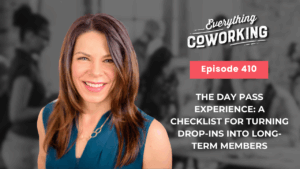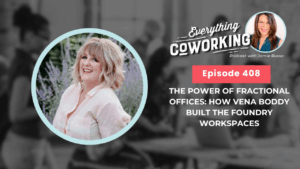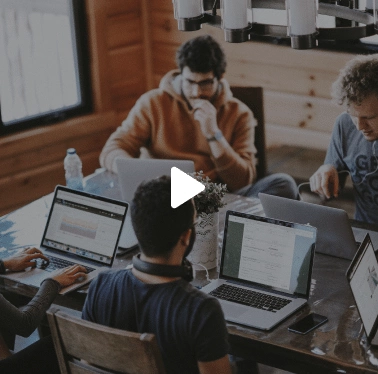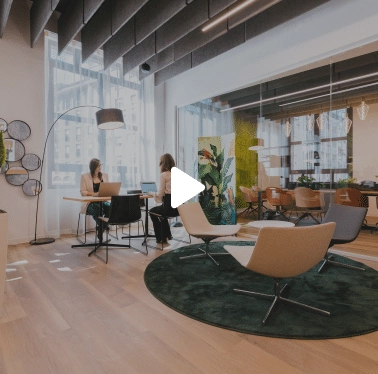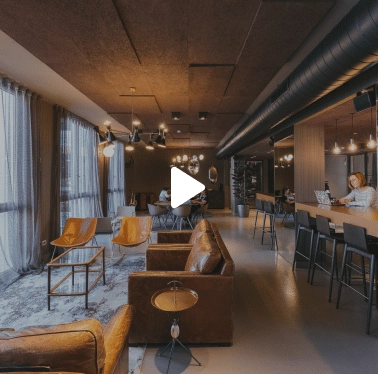“If you build it, they will come.”
This is the line from the 1989 movie Field of Dreams that has led small business owners down the path of failure for decades. There are a few other reasons that businesses fail, which I addressed in episode #83 – Top 5 Reasons Why Coworking Spaces Fail. The “If you build it they will come” fallacy is definitely on the list.
You need a sales funnel system and you have to work extra hard during your launch stage to get leads into the top of your funnel. We’re going to go through each layer of the funnel in detail, but let’s start here…
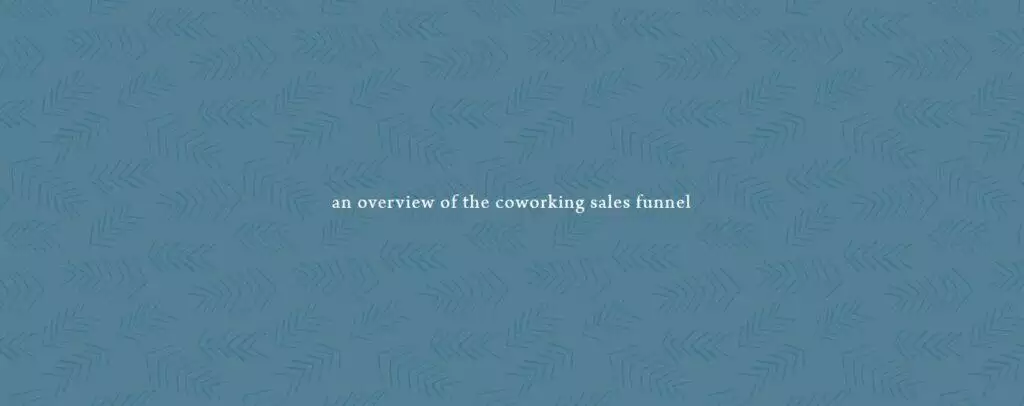
Starting at the top, we have leads that come from a variety of sources. Where do we want those leads to go? To your website to book a tour.
“Your ultimate goal is to convert them into a recurring member.”
Once you get the lead into your space, you want to match their needs to their intangible goals of community, productivity, sense of belonging, etc. You want to match their tangible physical space needs to the inventory available in our space.
Your ultimate goal is to convert them into a recurring member.
If they don’t convert on-site, then they are classified as a warm lead that we nurture through our tour follow-up sequence. The funnel is fairly simple and there are a number of levers to pull to drive more conversion at each stage. The critical path to success is constant focus on getting leads into the top of the funnel and improving each step along the way.
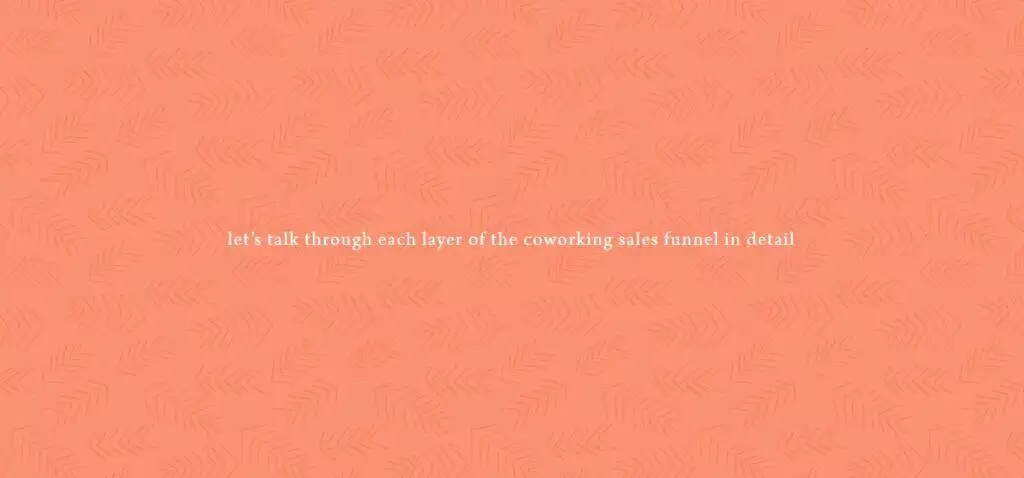
Let’s start at the bottom of our funnel because this is the end goal and drives how we approach the higher levels of the funnel. You should determine your own end goal and adjust your sales funnel accordingly. If you need help with this, see my post on “How big should my coworking space be?”
1. THE BOTTOM OF THE SALES FUNNEL – THE END GOAL. START WITH THE END IN MIND.
In the definition of sales funnel that we are using in this article, we are focusing on a goal of building a recurring membership base that creates a certain net income at the end of a 12 month period. There are a lot of non-financial goals and outcomes around starting a coworking space such as building community, helping businesses to grow, economic development, creating an on-site amenity that grows revenue for the rest of your real estate portfolio, and so on, but this particular discussion is around the net income number.
“Do we have the right size of space and product mix to make this happen?”
So let’s start with that number. For easy math, let’s say it’s $100,000. Assuming your margin is 25%, that means you need to make $400,000 in revenue.
So, how do we do that?
Let’s back into it.
First, do we have the right size of space and product mix to make this happen? This is critical. If you need some more context on this, listen to episode #72 which tries to provide a framework for thinking through the size of your coworking space. This is a helpful exercise to do before you sign a lease. If you already have a space, this will be a good reality check to understand your profit potential.
So, you need to make $400,000 in revenue. Pull out your pro-forma. Make sure your revenue potential matches your goal. Do you have the right amount of inventory of offices, dedicated desks, flex seating, meeting rooms, event space and other revenue-generating spaces and opportunities like virtual mail, to make this happen?
If you have not done a pro-forma yet, the very simple explanation on how to do this is to take the number of each product type and multiply it by the sales price and add it all up.
If you’ve determined it is indeed $400,000, great. If not, let’s update our revenue goal to match our inventory. One note here – when doing this exercise before you open, I would be conservative and not assume you are going to over-sell flex-seating or hit the lottery with virtual mail members until you prove that you can. Let these two opportunities provide upside vs. a potential disappointment to your financials.
“Can you fix your product mix and get a payback on that change before your lease runs out?”
Now, what if you already have a space, you complete this exercise and you come to the realization that you didn’t really think through this and you’re in trouble? The revenue potential is nowhere near what you thought it was. OR you’ve been open for a year or 2 and your product mix has the potential on paper to yield your $400k goal, but it’s not happening. What do you do?
This is a fairly simple math problem that may or may not yield the result you’re hoping for. Can you fix your product mix and get a payback on that change before your lease runs out? Focusing solely on product mix here (not on location or marketing budget). For example, it’s clear to you from your tour feedback and sales numbers that you more easily sell the offices that you have than the open flex space. For every 6 tours that come in, 4 want offices and 2 want open space. And to take that a step further, if you have an open office, it sells within 5 days but an empty dedicated desk takes 60 days.
Can you build more offices and make a return on them in the time you have left on your lease? How many months do you have left on your lease? What’s your price per office? Say you have 4 years left on your lease or 48 months. A four-person office in your market sells for $1800. That’s a potential revenue of $86,400 for one additional office over 4 years.
Now determine how much it costs to put in a new office including permits, drawings, walls, electrical, hvac, furniture, ethernet ports, anything you need to do to update the space if pulling permits triggers an update (like LED lighting in California).
I typically estimate about $10k per office depending on labor and furniture costs. Great. Your payback time is only 5 months and you have 48 months left on your lease. That’s 43 months of profit-making potential. If you have the space to add offices (converting open space to offices) access to capital, access to labor and a reasonable permit timeline, you can fix your product mix or inventory problem.
One quick note I’ll make here – there are a couple of companies that are making it really easy to add walls to your space without pulling permits. Emagispace and Varidesk. You will not yet find the Varidesk solutions on their website but they’re coming. We recently got a quote from Emagispace to add two more offices to get out in front of a big rent increase coming our way. You can get the walls shipped in 7-10 days and 2 offices assembled within 1 day. The walls are considered furniture so they generally don’t trigger sprinkler requirements. You likely do want to make sure that the room has the right air flow and a sprinkler.
Now let’s move back to the top of the sales funnel.
2. THE TOP OF YOUR COWORKING SALES FUNNEL – GETTING RELEVANT VISITORS TO YOUR WEBSITE
If you have the product mix that you believe is in demand in your market, your next step is to sell it! You need to get people into your space. Now we’re really back to the “If you build it they will come” fallacy. “They” defined as people actively searching for workspace, will come if you show up in their search.
“There are two ways to show up toward the top of the Google Search Results page.”
If you are in a small market, with only 1 or 2 other coworking spaces, then you might just get lucky and show up in the first few search results on the Google search results page without doing much work. However, If you are in a market with competition, then you are fighting your way to the top from the bottom!
There are two ways to show up toward the top of the Google Search Results page.
- Organic SEO or search engine optimization which means that Google has deemed you the most relevant result for a particular search.
- Pay Google to let you win by spending money on Google Adwords?
I’m simplifying this a great deal because this could be a very, very deep topic. But generally, you want to start putting resources toward building your SEO ranking and in the meantime, paying to win.
HERE’S WHAT THAT CONTENT MARKETING FOR A COWORKING SPACE MIGHT LOOK LIKE:
- Post 2-4 blog posts with relevant keywords each month. For content marketing support specific to the coworking industry, Cat Johnson is my go-to resource. Her website is Catjohnson.co. Spending your time writing blog posts is not “free” per say, but it will reduce your spend on marketing over time. You will need to write these posts or hire a writer. Time is not free therefore this is not free but the expense of a writer is relatively low and this is an investment in your search results ranking future.
- Actively promote your content on social media and via email marketing so that you drive visits to your blog posts which signals to Google that you have relevant content (the next step of course is to have good content that people actually read so that Google continues to rank you for this article).
- Complete your Google My Business Listing and update it regularly with reviews, photos and offers. As I mentioned repeatedly on the podcast, my GMB listing gets 20x the traffic that my website gets, likely because so many users are searching via mobile. Your GMB listing is free.
- Try to get backlinks. Another key measure that Google uses to determine your ranking is how many other sites link to you. This can be challenging for a new site. Getting backlinks will require some hustle and bartering. Local press, coworking directories, etc, will help build authority.
A great resource for SEO in general is SEM Rush and a book from Andy Crestodina called Content Marketing Chemistry (it’s not super long and it’s very approachable).
“You will want a professional that can help you determine if you can afford to compete with entrenched competitors with large budgets.”
SEO takes a good 6 months to start kicking in and moving you up the search result page… and remember, you’re competing with your neighboring spaces for who is willing to be the most consistent on these fronts. Hard work and consistency pay off over time with SEO.
While you’re putting in your SEO work and waiting for that to start humming, you have memberships to sell and you’ll want to pay Google to get a good spot on that search results page. Find a reputable Google Adwords professional to get you started. Warning – if you are in a top tier city, this might be an expensive endeavor. You will want a professional that can help you determine if you can afford to compete with entrenched competitors with large budgets. That being said, if people are paying for keywords, that generally means there’s a ROI for them. If AdWords is out of reach, then consider FaceBook Ads and Yelp Ads or whatever search apps are most popular in your local area (I know this differs outside of the U.S.).
Determining how to optimize the dollars you spend and the time you spend getting the most relevant traffic to your website will take time — you will need to test, assess, tweak and repeat. But this is important work because you need a certain amount of traffic in the top of your funnel to get to your goal net income at the bottom of the funnel. More on that math coming soon.
LET’S NOTE SOME OTHER ACTIVITIES THAT CAN FEED THE TOP OF YOUR COWORKING SALES FUNNEL:
- Hosting and attending events.
- Hiring a direct salesperson to engage in business development activities – for example, networking to develop strategic relationships that will drive ongoing referrals.
- Lead generation partners such as CloudVO, Davinci Virtual Office, Liquidspace, Office Freedom, Instant Office, Searchofficespace.com.
- Social media posting.
- Attracting local influencers to your space.
- Having great Google and Yelp reviews to signal to active searchers that you have the solutions that they need.
Note: I sometimes see posts in the Everything Coworking Facebook Group or asked in my Flight Groups from people that seem a little frantic over filling their space and they are looking for a marketing “silver bullet.” There are no “get rich quick” tricks in filling a coworking space. For a 10,000 to 20,000 square foot space, it may take you 18 months to ramp up to a stabilized occupancy rate of 90-95%. Plan for this and along the way, be brutally consistent with your marketing tactics. Treat these activities as if your business depends on them. Because it does. You won’t see results in a big bang – you will see results, slowly over time as your sales funnel gains traction.
Now that you have some consistent activities in place to drive traffic to your website, which is the top of your funnel, let’s move a step down in the coworking sales funnel.
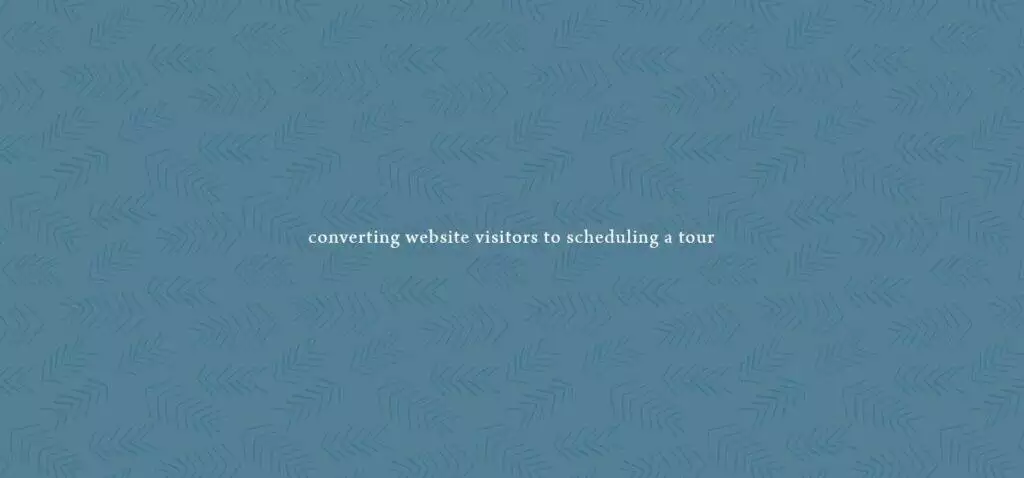
Now your goal is to convert a percentage of your website visitors into tours because you and I know that once you get them in the door, to know you is to love you.
Let’s take a moment to talk about math. There might be 500,000 people in your metro area. Some small percentage of this group is a) in your geographic target market and b) actively looking for a workspace at any given time. So when you’re thinking about your “market size,” make sure to whittle it down to the population of self-employed/business owners/remote corporate employees within, say, a 5-mile radius of your space… So that might get the number down to say, 20,000. And then what percentage of that group is actively looking for space at any given point in time? 1%? What’s 1% of 20,000? 200. When they come to your website, you need to suck them in! Magnetize them, and give them what they want immediately! An address, membership options, pricing, a sense of what your space offers in terms of vibe and culture. You have a lot of work to do in the few seconds that the visitor will spend assessing whether or not you can solve their problem.
Your website might have thousands of visitors per month that don’t fit into your target market. So when you’re looking at your conversion number which is calculated by dividing number of tours booked by number of website visitors, that number will typically be very small. Which is why you must do everything you can at this level of the funnel to avoid LEAKAGE.
What is leakage, you are wondering? Leakage happens when you have a website visitor whose problem you CAN solve but leaves your website without booking a tour because you made it too hard. Your users are busy, impatient, distracted and did I mention impatient?
Here’s an example:
ANNA IN ATLANTA
Anna started a marketing consulting firm. She has been working from home but she’s about to hire a new team member and doesn’t want to have team meetings at her kitchen table. So she’s ready to build an office into her budget and kind of excited about getting out of her house, having a routine, meeting new people and making friends. She’s ready to find her tribe. She Googles for coworking spaces in Atlanta and finds five that are within her preferred commute time of 20 minutes and decides to peruse their websites, book tours for Wednesday to tour them and then she’ll do trial days at 2-3 of them.
“She wants to find the right space but can’t spend a lot of time on it.”
Anna starts diving into websites. She has about a half hour to look through all of them because she has client calls all day and deadlines she needs to hit for them. She wants to find the right space but can’t spend a lot of time on it. She could have her assistant do the research for her, but she really wants to get a sense of the vibe of the space before she wastes time touring.
The first website she finds is yours (wahoo!!) because you’ve done all the right things…. Google ad, Google My Business listing, content marketing, active social media accounts. You’re in the top three results on the search results page. Your Google and Yelp reviews are very positive and you have 2-3 from each month that you’ve been open.
She starts scanning your homepage…. She loves the images of people in your space that she feels like she can relate to. She scans your membership packages – those look good. Then she tries to figure out exactly where you are located and can’t find your address anywhere on the home page. She is starting to get impatient because she has four more spaces to research before her next client call but she sticks with you and clicks on your “contact us” page where she finally finds your address with an accompanying map of the area.
She makes a few notes and thinks she’ll probably come back and schedule a tour.
She quickly moves through the other websites, makes notes and narrows her list to the three she wants to tour. She wants to do all of the tours on Wednesday and make a decision. She goes back to your website to book a tour – she also wants to know if your space is dog-friendly because she’d like to bring her dog in on days when her dog walker is out of town.
“She likes your space but is feeling frustrated that it’s not as user-friendly as the others”
The other websites supported online booking – she could just click a button and choose a time to come in for a tour that worked for her. Super easy. Yours however, doesn’t have that – it has a contact form so she has to fill in several fields and request a tour time and wait for you to respond. She also doesn’t see an answer to her dog-friendly concern on your website and there’s no phone number for her to call and ask. She likes your space but is feeling frustrated that it’s not as user-friendly as the others so decides to tour the other two spaces first and then if she doesn’t love them, she’ll add yours to the list.
She tours the other two spaces, one of them seems to fit the bill and she chooses that one. You lose Anna.
HERE ARE SOME POTENTIAL LEAKAGE POINTS IN YOUR SALES FUNNEL ONCE YOU GET SOMEONE TO YOUR WEBSITE:
- Potential member wants to know where you are. Just because YOU know where you are doesn’t mean others do. If I had a dime for every coworking space without an easy-to-find address for their space on their website….
- Potential member wants to see your membership options and they have to click too many times to get to them or called crafty names that are hard to understand…
- Potential member wants to understand who else is a member of the space and if it’s a right fit for them socially, professionally, etc., but your photos are stock photos or don’t have any actual members in them. You don’t showcase any members, nor do you have any member profiles on your blog. Your social media curates generic entrepreneurial content and doesn’t give any clues as to who actually works in the space.
- Potential member wants to book a tour…
- And you make them fill out a form. In today’s day and age where you can book a restaurant reservation with a swipe of your finger, rent a house in Bora Bora with a click of a mouse and ask Siri to get you an uber, you’d better make it as easy as possible for your potential customers to book a tour on your site. Having to fill in a contact form and play email tag will lose anyone that doesn’t have some specific reason to need to be in your space (i.e., it’s the closest to home).
- Potential member wants to ask a question and book a tour.
- Potential member wants to ask a question before booking a tour
- For the Love of God, have your phone number on your website. Let them call you if that’s what they prefer. And if they call, you’d better pick up that phone. See my blog post on how you can beat the competition just by answering the phone.
- Have a live chat option available. People are used to texting and messaging. Use a LiveChat app that your staff mans or outsource it to Davinci Virtual Office Solutions (we do).
SNEAKING INTO YOUR FUNNEL: YOUR PROSPECTIVE MEMBER NEVER EVEN GOES TO YOUR WEBSITE!
Todays searchers have a myriad of ways that they might get to you. They might search on their laptops and are most likely to be on Google. Google has about 75% market share overall and 90% market share on mobile.
Make sure that your site is mobile-friendly/responsive because “More Google searches take place on mobile devices than on computers in 10 countries including the US and Japan” and, in 2017, mobile accounts for 50.3% of all web traffic generated worldwide.
Speaking of mobile, my Google my Business listing gets 20x more visits each month than my website. I don’t have data on this across coworking spaces but I encourage you to check yours.
How important is my Google my Business listing? “Critical. It’s the centerpiece and fundamental to any local campaign! You simply don’t exist if you don’t create a Google my business page for your local business.”
A FEW IMPORTANT THINGS TO NOTE ABOUT OPTIMIZING YOUR GMB LISTING:
- Make sure it’s complete.
- Take it really seriously, like your website. Google wants to see dynamic content. Add photos and encourage reviews on a regular basis.
- Create offers monthly and test them.
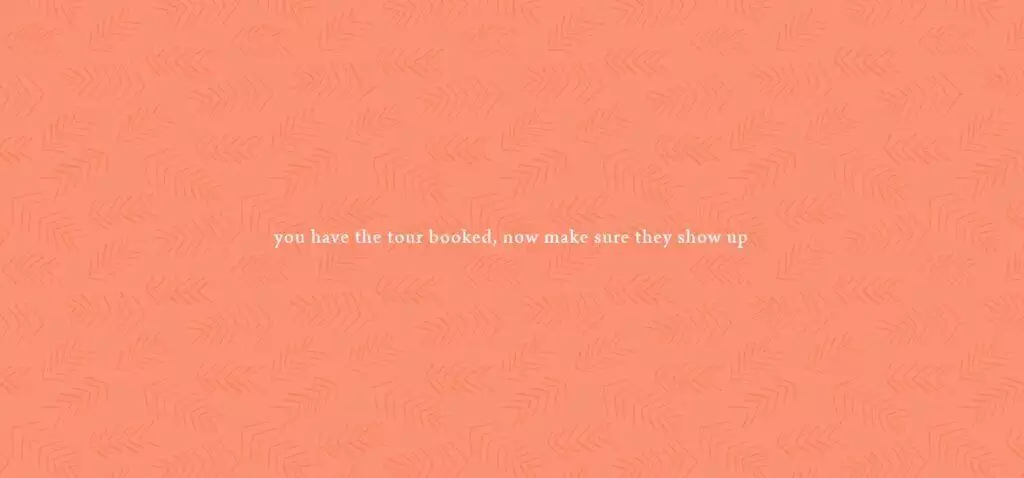
Your prospective member has booked a tour through your website after asking a couple of questions on your Live Chat.
“Are they committed to the tour?”
You know that you have a high conversion rate on tours so you really want to make sure they come in for a tour. But they’ve just booked a tour on your website. Did they put the event in their calendar? Are they committed to the tour?
What can you do to ensure that they show up on Tuesday at 3pm?
- Set up your tour booking plugin to offer an option for the user to add the appointment to their calendar once they book.
- Send them an invite from your business calendar.
- Collect their phone number and send them a text message reminder.
- Call them and remind them.
- Send them an email confirmation upon booking with any special directions on parking and accessing the space.
- Send them a reminder email the day before the tour.
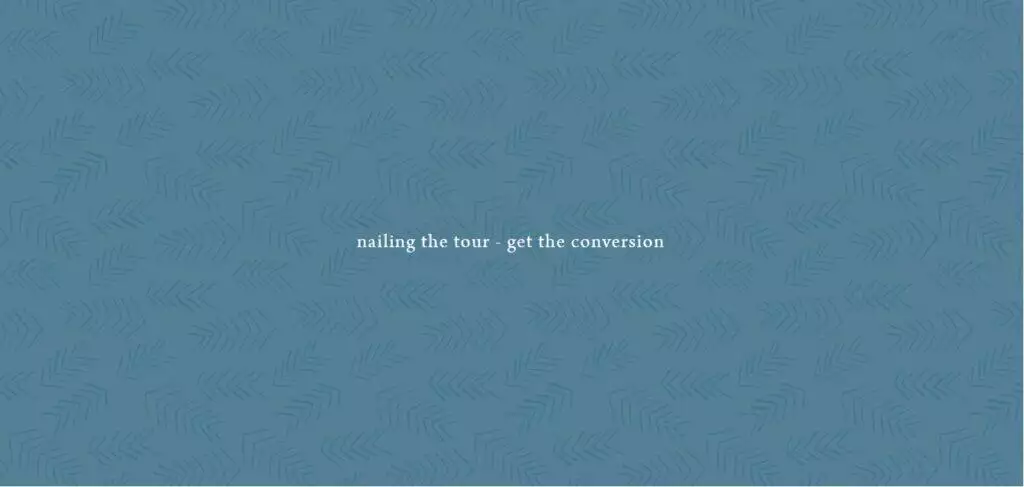
BEFORE THE TOUR
Getting a prospective member on-site for a tour is another critical point in the sales funnel and now the prospect is yours to lose. Ensure that you have a clear tour-day process documented and that your staff is trained to manage and execute the process.
SEVEN TOUR-DAY CONSIDERATIONS:
- Is the member set up to get into your space with no frustration? Do they know where to park (if relevant) and how to access the door of your space? Is your entrance clearly marked with directional signage (as much as possible depending on your building rules)?
- How is the member greeted when they enter the space? Will your community manager or sales manager be able to ensure that he/she is at the front desk when your tour arrives? If not, how can you make sure that he/she is?
- Has your tour guide researched the prospective member so that she can immediately ask relevant questions and create common ground? A simple LinkedIn search will often yield enough information to make some connections – previous jobs, mutual connections, educational background, where the person has lived, etc. Consider having your staff add any relevant LinkedIn notes to the prospective members’ entry in your CRM.
- Does your tour guide have a prescribed path through the space as well as a discussion flow with key talking points to go through with the prospective member? In my experience, this is critical. In no organization should sales staff go untrained. Most people are not 100% “natural” at selling. You may not like to think of this process as selling – you may prefer to think of it as attracting the right members to your space. It’s OK to frame the process as something other than “sales,” however, I recommend you still approach it as a sales process in order to optimize conversions to get to that end goal of financial sustainability.
- What “special sauce” tactics do you integrate into your tour process? Does the prospective member get introduced to a current member? Is the prospective member invited to attend a member event? To stay for the day to work?
- What is the process for your staff to get to know the prospective member throughout the tour? A list of questions? A brief sit-down with them in a meeting room before the tour starts?
- How does the tour end? An offer for a trial day? A list of questions to understand where the prospective member is in their selection process? Asking them if they’re ready to make a membership selection? If they’re not ready to make an immediate decision, make sure to ask them:
- Where else are they touring?
- When do they plan to make a decision?
- Are they the decision-maker or will that be someone else on their team?
- What questions can you answer that haven’t yet been answered on the tour process?
As your tour guide wraps up the tour, he/she should let the prospective member know that you’ll send them a follow-up email including pricing and membership details. Mention this at the beginning of the tour so they know they don’t have to take notes on those items during the tour, and then at the end, which sets an expectation that you will follow up with them via email, but in a way that is helpful to them.
THE TOUR FOLLOW-UP
If your prospective member has left the space without signing up on-site, the next best outcome is that they’ve agreed to sign up when they get home. If this is the case, send them, the next action they need to take immediately. “Time kills deals” is my favorite quote from a sales guy I used to work with. It’s true. People get distracted, change their mind about their budget, get busy with work projects and push off the decision, etc. If they’ve said they’re ready, send your sign-up links immediately and get that member signed up!
“Time kills deals.”
If the prospective member is not yet ready to sign up, put them into a tour follow-up process that you should automate in your CRM.
A TOUR FOLLOW-UP PROCESS MIGHT LOOK LIKE:
- An email (same business day if possible) detailing pricing and membership options with a personalized note related to a connection you made on the tour.
- If you really want to make an impression and give the prospective member a flavor of your team, send them a video-follow up using a service like Loom or Bombomb.
- Set up a post-tour email automation through your CRM/email service provider that runs after your personalized follow-up. It might look like this:
- 2 Days after the tour: “Any questions for us?” email – send a short email thanking them again for visiting the space and asking them if they have any lingering questions after their visit that you can answer.
- A week after the tour: “Checking in to see if we can help you make your decision” email – Again, keep the email short – this is just a way to try to stay top of mind with them and nudge them along if they’re ready to join but got distracted with other business/life needs.
- Two weeks after the tour: “Invite to a member event or a trial day” email – If they still haven’t committed, but you think they’re a warm prospect, consider inviting them to an upcoming member event. In order to automate this email, the event will have to be one that you host on a regular day/time of the month. As an alternative, you could offer them a free trial day and automate the email with the offer and instructions on how to redeem.
- Three weeks after the tour: Drop them into your email marketing list so that they receive your monthly newsletters. This will keep them connected to what’s happening in the space if they a) haven’t made a decision yet or b) join another space but aren’t 100% happy there.
The process above is a framework. The intensity and duration of the follow-up is up to you. WeWork appears to send follow-up emails until you tell them that you are not going to join. They are following the “I’ll keep communicating until you turn me down’ approach. This may or not be a fit for you.

I’ll leave you with a list of sales-funnel-related resources that you might leverage:
CRM:
There are a lot of CRM options in the marketplace. So many. Do not get into analysis paraylsis on this decision. Determine what you want the CRM to be able to do. Pick a few that fit the bill, set a deadline for researching and choose one.
A FEW COMMON CRM OPTIONS INCLUDE:
- Nutshell
- Hubspot
- Zoho
- Salesforce
STOP THE FUNNEL LEAKS:
- Run your own live chat – use LiveChat (both desktop and mobile for each access)
- Outsource your live chat to Davinci Virtual Office Solutions
- Outsource your phone answering to CloudVO or Davinci Virtual Office Solutions
GET HELP WITH CONTENT MARKETING
For additional coworking tech and tools recommendations, download the 2018 Coworking Tech and Tools Guide.
Looking to connect with other Everything Coworking Podcast Fans? Join our Facebook Group here!

